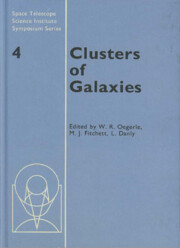Book contents
- Frontmatter
- Contents
- Preface
- Participants
- Chapter 1 Cosmology and Cluster Formation
- Chapter 2 Clusters of Galaxies: Structure, Infall, and Large-Scale Distribution
- Chapter 3 Cosmogony with Clusters of Galaxies
- Chapter 4 Cosmogony and the Structure of Rich Clusters of Galaxies
- Chapter 5 The Dark Matter Distribution in Clusters
- Chapter 6 The Effect of the Cluster Environment on Galaxies
- Chapter 7 Evidence for Gas Deficiency in Cluster Galaxies
- Chapter 8 Properties of Galaxies in Groups and Clusters
- Chapter 9 Dynamical Evolution of Clusters of Galaxies
- Chapter 10 Hot Gas in Clusters of Galaxies
- Chapter 11 Hydrodynamic Simulations of the Intracluster Medium
- Chapter 12 Evolution of Clusters in the Hierarchical Scenario
- Chapter 13 Distant Clusters as Cosmological Laboratories
- Chapter 14 Future Key Optical Observations of Galaxy Clusters
- Chapter 15 Cluster Research with X-ray Observations
- Plate section
Chapter 7 - Evidence for Gas Deficiency in Cluster Galaxies
Published online by Cambridge University Press: 06 July 2010
- Frontmatter
- Contents
- Preface
- Participants
- Chapter 1 Cosmology and Cluster Formation
- Chapter 2 Clusters of Galaxies: Structure, Infall, and Large-Scale Distribution
- Chapter 3 Cosmogony with Clusters of Galaxies
- Chapter 4 Cosmogony and the Structure of Rich Clusters of Galaxies
- Chapter 5 The Dark Matter Distribution in Clusters
- Chapter 6 The Effect of the Cluster Environment on Galaxies
- Chapter 7 Evidence for Gas Deficiency in Cluster Galaxies
- Chapter 8 Properties of Galaxies in Groups and Clusters
- Chapter 9 Dynamical Evolution of Clusters of Galaxies
- Chapter 10 Hot Gas in Clusters of Galaxies
- Chapter 11 Hydrodynamic Simulations of the Intracluster Medium
- Chapter 12 Evolution of Clusters in the Hierarchical Scenario
- Chapter 13 Distant Clusters as Cosmological Laboratories
- Chapter 14 Future Key Optical Observations of Galaxy Clusters
- Chapter 15 Cluster Research with X-ray Observations
- Plate section
Summary
Abstract. On-going removal of the low density outer interstellar HI gas occurs in galaxies passing through the central regions of clusters with moderately high X-ray luminosity. Although the galaxies currently maintain their spiral morphology, they are HI deficient by as much as a factor of ten relative to their counterparts at larger cluster radii or in the field. The HI distribution in deficient galaxies is truncated well interior to the optical radius as the gas is removed preferentially from the outer portions. In contrast, the molecular hydrogen component, derived from observations of CO, seems undisturbed. Galaxies that are HI poor by a factor of ten may be gas poor by only a factor of three. At the same time, other indicators suggest a reduction in the star formation rate in most H I deficient galaxies, but some objects may suffer an enhanced gas depletion if star formation is actually induced by the interaction. While the intracluster medium is the likely catalyst for gas removal, the exact sweeping mechanism is unclear. Early-type objects seem to be even more HI poor than late-type ones, perhaps supporting the suggestion of a fundamental difference in the orbital anisotropy of early and late type spirals. While it seems possible that after disk fading, stripped spirals would ultimately resemble S0's, it is unlikely that all S0's result from such gas sweeping events since the process seems viable only in the cores of rich clusters.
- Type
- Chapter
- Information
- Clusters of Galaxies , pp. 177 - 200Publisher: Cambridge University PressPrint publication year: 1990
- 4
- Cited by

